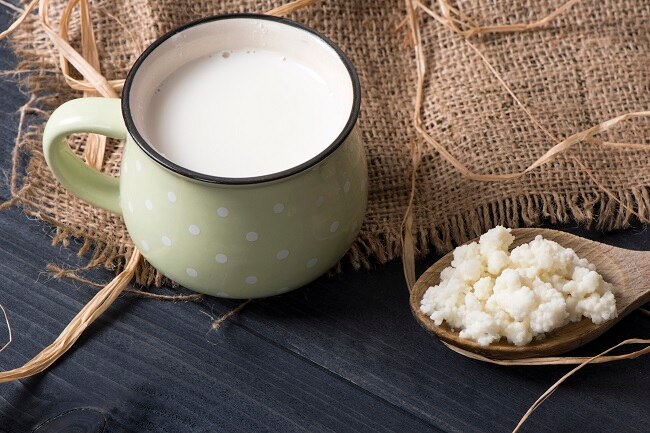When it comes to fermented foods, items like yogurt and sauerkraut probably comes to mind. But what about beverages? Beer, wine and kombucha are all fermented. Kefir is another less-known fermented beverage that deserves a little more attention than it’s been given. Widely popular in Asia and Europe, kefir has been recently receiving more attention in the U.S. as well – and for good reason!
What is kefir?
Much like yogurt, kefir is a product of cultured milk. (The pronunciation of kefir is ka-feer and rhymes with the word ‘fear’.) Kefir grains (or kefir starter, in powder form) that contain bacteria, yeast and milk proteins are added to pasteurized milk that has been heated. The mixture is then left to ferment for over 24 hours. Afterwards, the grains are strained and the result is a thick and creamy product liquid. Its consistency is less thick than yogurt.
Is kefir dairy?
While kefir is commonly made from cow’s milk, there are actually different types of kefir. Goat milk kefir is sold in stores, as is sheep milk kefir. Non-dairy milks, such as coconut milk, can also be used to make kefir.
While dairy plays a large role in the fermentation process, kefir may be a good option for people who are lactose intolerant, as the lactose is turned into lactic acid during fermentation. Additionally, the enzymes formed in the fermentation process can help break down any remaining lactose.
How to use kefir
With a tangy and almost sour flavor, people often consume kefir in place of buttermilk, but it can also be used in place of milk. Add it to soup or smoothies and eat it with cereal or granola. Many people enjoy kefir on its own – either eaten with a spoon or drank through a straw.
Kefir benefits
Like milk and yogurt, kefir offers many health benefits. The name is actually derived from the Turkish word, keyif, which means “feeling good.”
Kefir is rich in calcium, protein, phosphorus, vitamin B2 and B12 and magnesium. However, its recent popularity in the U.S stems from the amount of beneficial bacteria, or probiotics, present. One of the most probiotic-rich foods, kefir actually contains more probiotics than yogurt. Yogurts typically have a few strains of probiotics while kefir may contain as many as 30 strains! (Read more about the benefits of fermented foods.)
What are probiotics?
Your body is home to millions of bacteria. Often referred to as “good” bacteria, probiotics help keep your gut healthy and balanced. They have been associated with a wide range of benefits, including supporting digestion and immune function.†
Our bodies cannot produce these bacteria, so we must obtain them from food and supplementation. Kefir, and other fermented foods, are good sources of these bacteria. Not a fan of kefir or yogurt? Consider taking a probiotic supplement, which provides beneficial bacteria in capsule form.
How to make kefir
Shop for kefir in the refrigerated section of your grocery store. Do you like to DIY? Learning how to make kefir at home is a fun project! If you’ve never tried it before, following a fermented food recipe might seem a little intimidating – but it shouldn’t be! With a starter culture kit, like Cultures for Health, you can make all kinds of fermented foods, from kefir and yogurt to sourdough bread and tempeh.
Need a kefir recipe? Try Homemade Kefir with Coconut Milk for a version of vegan kefir.

